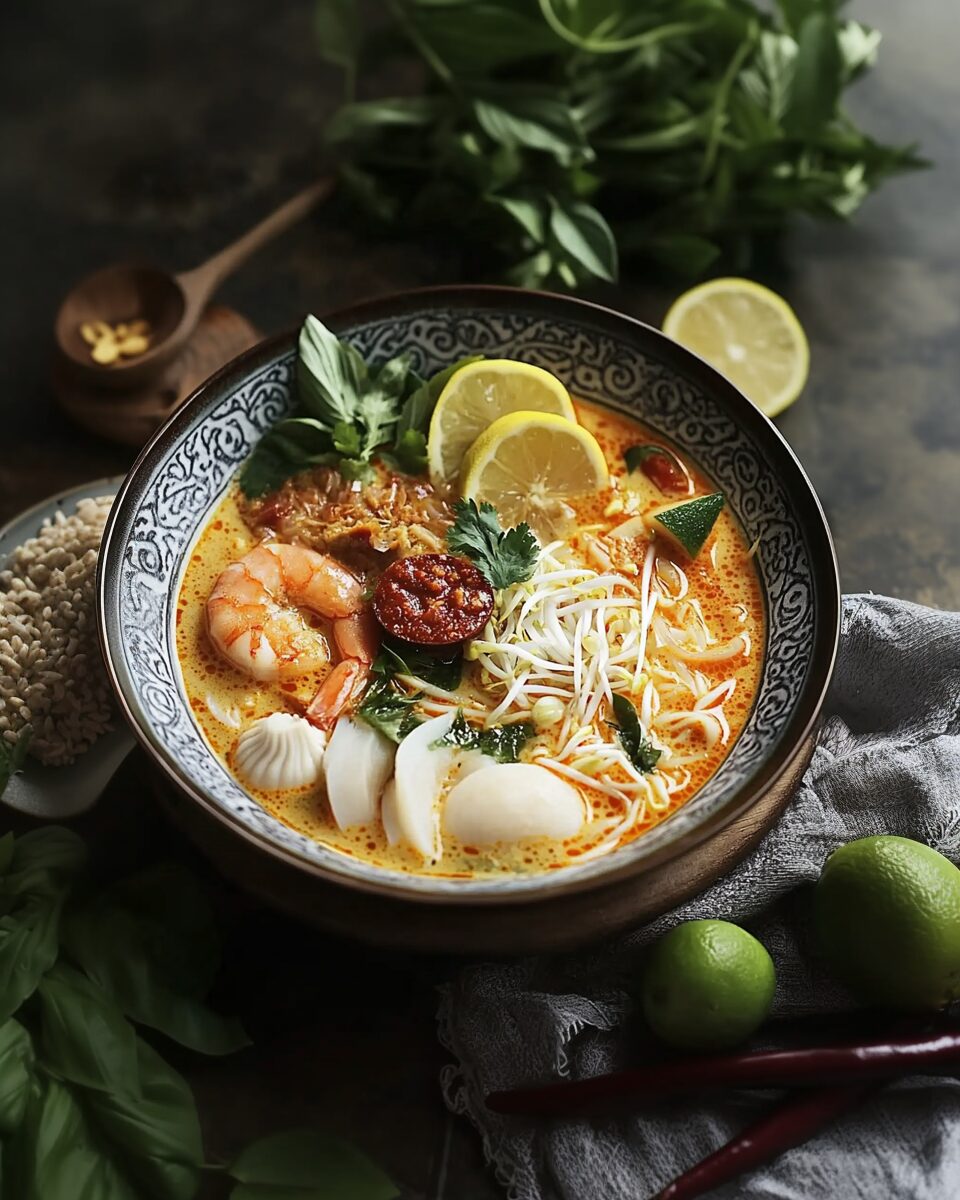Laksa is a popular Southeast Asian dish that combines spicy coconut curry broth with noodles, offering a rich and flavorful experience. This comforting soup is perfect for those who enjoy bold flavors and a hint of spice.
Full Recipe:
Ingredients
-
200g rice noodles
-
1 tablespoon vegetable oil
-
2 cloves garlic, minced
-
1 tablespoon ginger, grated
-
2 tablespoons red curry paste
-
400ml coconut milk
-
500ml chicken or vegetable broth
-
200g cooked chicken breast, sliced (optional)
-
100g tofu, cubed (optional)
-
100g bean sprouts
-
2 boiled eggs, halved
-
Fresh cilantro, chopped
-
Lime wedges
-
Salt and pepper to taste
Directions
-
Cook the rice noodles according to package instructions. Drain and set aside.
-
In a large pot, heat the vegetable oil over medium heat. Add the minced garlic and grated ginger, sautéing until fragrant.
-
Stir in the red curry paste and cook for another minute.
-
Pour in the coconut milk and broth, stirring to combine. Bring the mixture to a simmer.
-
Add the cooked chicken or tofu, if using, and let it heat through.
-
Season the soup with salt and pepper to taste.
-
Divide the cooked noodles between serving bowls and ladle the hot soup over the noodles.
-
Top each bowl with bean sprouts, boiled egg halves, and fresh cilantro. Serve with lime wedges on the side.
Nutrients
Per serving (approximate values):
-
Calories: 450 kcal
-
Protein: 25g
-
Carbohydrates: 50g
-
Fat: 18g
-
Saturated Fat: 12g
-
Fiber: 3g
-
Sugar: 5g
-
Sodium: 800mg
Historical Origins
The story of laksa is intricately tied to the melting pot of cultures found in Southeast Asia. Historians generally agree that laksa emerged from the Peranakan community, a group of Chinese immigrants who settled in the Malay Archipelago and intermarried with the local Malays. This intermingling of Chinese and Malay influences created a hybrid culture known as Peranakan or Straits Chinese, and their cuisine—Nyonya cuisine—is where laksa first began to take shape.
Peranakan cuisine is known for combining Chinese cooking methods with local Southeast Asian spices, herbs, and ingredients. The result is a bold and complex flavor profile, often including coconut milk, tamarind, lemongrass, and galangal. Laksa, in this context, represents a culinary metaphor for multiculturalism—a dish born from the interaction of diverse ethnicities and tastes.
Though laksa’s exact origin story remains debated, its cultural roots are firmly embedded in the regions where these communities thrived, especially in Malaysia and Singapore.
Etymology of ‘Laksa’
The word “laksa” has an uncertain origin, but several theories exist. One suggests it comes from the Sanskrit word “laksha,” meaning “one hundred thousand,” possibly referring to the variety of ingredients or the multitude of flavor notes present in the dish. Another theory posits that it derives from the Persian word “lakhshah,” which refers to a type of noodle—hinting at laksa’s noodle-based composition.
Regardless of its linguistic history, the name “laksa” has become synonymous with comfort food in Southeast Asia, evoking warm memories and the scent of aromatic spices wafting through bustling street markets.
Types of Laksa
Laksa is not a monolithic dish. It comes in numerous variations depending on local tastes, available ingredients, and cultural preferences. Some types are sour and tangy, others rich and creamy. The two broad categories are Curry Laksa and Asam Laksa, but within those are even more regional variations, each telling a different story.
Asam Laksa
This version hails from Penang in northern Malaysia and is known for its tangy, fish-based broth. The term “asam” refers to tamarind, a key ingredient that gives the soup its sour kick. Traditionally, the broth is made from poached and flaked mackerel, tamarind paste, lemongrass, galangal, chili, and shrimp paste.
Thick rice noodles are used, and the soup is typically topped with shredded cucumber, onions, pineapple slices, mint leaves, and a generous dollop of dark shrimp paste. Asam Laksa is a punchy, palate-awakening dish that’s especially refreshing in tropical heat.
Curry Laksa (Laksa Lemak)
This is perhaps the most globally recognized version of laksa, commonly found in Singapore and Kuala Lumpur. It features a rich, coconut milk-based curry broth seasoned with a paste of spices like turmeric, chili, garlic, and lemongrass.
The proteins vary—some bowls include shrimp, others chicken, fish cakes, tofu puffs, or a combination. It is served with a mix of rice vermicelli and yellow egg noodles, and garnished with bean sprouts, boiled egg, fresh herbs, and lime. Curry laksa is creamy, spicy, and comforting—perfect for a satisfying meal.
Sarawak Laksa
Unique to the Malaysian state of Sarawak on the island of Borneo, this laksa has its own distinct flavor profile. The broth is a complex blend of sambal belacan (spicy shrimp paste), tamarind, garlic, galangal, and coconut milk. It is neither as sour as Asam Laksa nor as creamy as Curry Laksa but exists somewhere in between.
Laksa Johor
Laksa Johor is perhaps the most unconventional of all. Originating in the southern state of Johor in Malaysia, it uses spaghetti instead of rice noodles—a result of Italian culinary influence during the colonial period. The sauce is thick and made from ground fish, coconut milk, dried prawns, and an elaborate mix of spices.
Laksam
Laksam is popular in the northeastern Malaysian states of Kelantan and Terengganu. This version features thick, rolled rice flour noodles served in a creamy white gravy made from boiled fish and coconut milk. The dish is typically eaten for breakfast or lunch and is accompanied by fresh herbs and a spicy sambal on the side.
Laksa in Singapore
In Singapore, laksa has evolved into a national favorite. One of the most famous adaptations is Katong Laksa, named after the Peranakan enclave of Katong. This version is distinctive because the noodles are cut into short lengths, making it easy to eat with just a spoon.
Cultural Significance
Laksa isn’t just food—it’s a symbol of identity and a reflection of Southeast Asia’s diverse heritage. In places like Malaysia and Singapore, it represents unity in diversity. Every bowl tells a story of cultural fusion, colonial history, trade routes, and family traditions passed down through generations.
Health and Nutrition
Laksa, while indulgent and rich, also has some health benefits when enjoyed in moderation. Ingredients like lemongrass, turmeric, garlic, and ginger have known anti-inflammatory and digestive benefits. The broth is typically full of nutrients, especially when made with fresh herbs and homemade stock.
However, the use of coconut milk and fried ingredients means it can be high in saturated fats and calories. Health-conscious eaters can opt for lean proteins, increase the proportion of vegetables, or use lighter coconut milk alternatives to create a healthier version.
Laksa’s Global Expansion
Laksa has found its way far beyond Southeast Asia. In cities like London, Sydney, Toronto, and New York, modern restaurants have added laksa to their menus, often with innovative twists. Vegan laksa made with tofu and mushrooms, or seafood laksa using locally-sourced fish and shellfish, have become popular.
Some chefs are experimenting with laksa-inspired pasta, tacos, or even pizzas, using the spice blend in new formats. While purists may balk at these fusions, they demonstrate the dish’s flexibility and global appeal.
Cooking shows and travel documentaries have also played a role in raising laksa’s international profile. As more people become curious about bold, multicultural flavors, laksa is often highlighted as a perfect example of flavor layering and comfort food with a story.
Tips for Enjoying Laksa
Whether you’re a seasoned laksa lover or a curious first-timer, there are a few tips to enhance your experience. First, don’t rush. Laksa is best savored slowly, allowing the spices to unfold with each bite. Second, embrace the toppings—mint, lime, sambal, bean sprouts—all these elements are there for balance.
Conclusion
Laksa is more than a dish—it’s a celebration of culture, history, and flavor. From its Peranakan roots to its global presence, laksa has evolved while staying true to its essence: a bold, aromatic, and deeply satisfying noodle soup that brings people together. Its many variations offer something for every palate, whether you prefer the creamy comfort of Curry Laksa or the tangy zing of Asam Laksa.






